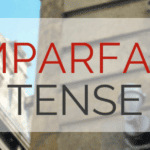
There are several common past tenses in French, including the passé composé, imparfait, and plus-que-parfait. The plus-que-parfait, the “past before the past”, generally translates directly into English, but when to use the imparfait vs. passé composé tenses tends to be more challenging for English speakers to determine. Many distinctions will intuitively make sense to most English speakers, but some instances might not.
The general rule for imparfait vs. passé composé
As a general rule of passé composé as a snapshot and imparfait as a video. In other words, if you imagine a certain action, could you capture it in fully in a picture? If you can, the correct tense is likely passé composé. But if a photo would not fully encompass the duration of the action, the correct tense is likely to be imparfait.
However, there is much more nuance in deciding which past tense to use than this basic rule. We’ll discuss many of the most common scenarios below.
When to Use Imparfait vs. Passé Composé
The three most common guidelines are to use the imparfait for :
- Setting a scene in the past
- Describing continual or ongoing actions in the past
- Describing how someone or something was or behaved in the past
Example 1: Setting a Scene
Generally, when you’re establishing what was going on (often with the implication that you’re then going to say something more specific happened), you should use the imparfait. The English translation will often be that something that “was” or “were” happening. For example:
“She was singing.” → Elle chantait.
“They were laughing.” → Ils riaient.
Example 2: Continual or Ongoing Actions
The imparfait is also for sentences that encompass either the idea of something happening in general, or that the word “often” or a close synonym is implied in the sentence. For example:
“He ran on Thursdays” → Il courait le jeudi.
“He cooked dinner every night.” → Il préparait le dîner tous les soirs.
Example 3: Describing How Something Was or How it Behaved
Finally, if a sentence describes how someone felt, it’s usually imparfait. For example:
“Tim wanted to leave.” → Tim voulait partir.
Similarly, imparfait can also describe something in the negative sense, that something “used to” happen but no longer does. For example:
“We used to go to France every summer.” → Nous allions en France chaque été.
When to use passé composé and not imparfait
The primary situations to use passé composé is to describe distinct, singular actions that occurred in the past. For example:
“He swam yesterday.” → Il a nagé hier
Passé composé is also used when describing repeated actions in the past, if they occurred a specific number of times. For example:
“He ran three times last week.” → Il a couru trois fois la semaine dernière.
In general, if a specific time period is used to describe an event, or if the event is clearly a one-time action that started and ended in the past, the correct verb tense is most likely to be passé composé.
Common Imparfait vs. Passé Composé patterns
Many sentences about the past involve both the imparfait and the passé composé. Learning the most common patterns will help you use the correct verb tense in your own speaking and writing.
Setting the scene + a specific event
A sentence that describes what was taking place when a distinct event occurred is a common imparfait + passé composé pattern. The event that was happening prior to the interruption is in imparfait, and the interrupting verb is in passé composé. For example:
“I was cleaning when I heard a voice.” → Je nettoyais [passé composé] quand j’ai entendu [imparfait] une voix.
Verbs that are usually Imparfait
Some verbs are much more common in imparfait form, so if you’re not certain of the correct tense, you should usually guess the imparfait. More common in imparfait are verbs of:
- Feeling (sentir)
- Having (avoir)
- Being (être)
- Seeming (sembler)
- Hoping (espérer)
- Knowing (savoir)
- Thinking (penser)
- Liking (aimer)
Final Tips for the Imparfait vs. Passé Composé
As a native English speaker, you probably will not choose the correct past tense all the time. Fortunately, using the incorrect tense will only rarely interfere with your ability to be understood by other French speakers, so we would suggest you make the best call that you can and move on with your sentence.
Next Steps
Hopefully you’re feeling more confident now about which type of past tense to use! If you haven’t already read about the plus-que-parfait, this might be a good time to, or you could move on to learning the subjunctive mood.



